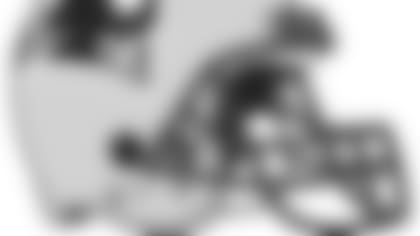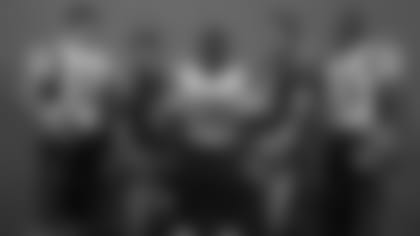1960 - The tri-corner hat logo

The name "Patriots" came from a fan submission contest with the winners eligible to win a new television set. The original logo, a blue tri-corner hat on a white background, was also from a fan - Somerville, Mass native and railroad employee Walter Pingree. This was also the only season numbers appeared on the sides of the helmets.
1961 - Pat Patriot snaps into place

Throughout the 1960 season, Boston Globe cartoonist Phil Bissel drew original cartoons for the game day programs which featured a Revolutionary War figure wreaking havoc on the Patriots opponents. Nicknamed "Pat Patriot," the cartoon appealed to team owner Billy Sullivan and he made an image of Pat getting ready to snap the ball the official logo in 1961.
1960-92 - Seeing red

Patriots uniforms did not change much over the first three-plus decades of the franchise. In all, the team consistently used red uniforms with white numbers and letters and white uniforms with red numbers and letters and opposite colored pants. After 1972, a blue outline appeared around the numbers and lettering.
The one aspect of the jersey that did change over time was the placement of the stripes. The first 1960 pre-season jerseys had no stripes at all. Later in the inaugural season, stripes were introduced on the shoulder - blue and red for the white jerseys, white and blue for the red jerseys. This style continued until 1969 when the stripes moved to the sleeve cuffs. By 1973, the stripes moved over the bicep where they stayed until 1984, the team's 25th anniversary season. That year saw the team go back to the stripes on the shoulders, where they would remain until 1993.
1976-80 - Pat prevails

While everyone associates Pat Patriot with this era, things got interesting in the late 70s. In an effort to capitalize on the success of the first Christopher Reeve Superman movie, the team introduced Super Patriot. Super Patriot was a hit until the team abruptly stopped using the mascot after an aborted motorcycle stunt late in the season.
In preparation for the 1976 US Bicentennial, the Patriots commissioned NFL Properties to create a new logo. While he was a fan favorite, the intricacies of the Pat Patriot design were hard to replicate in the increasingly important retail market. The 1976 project was shelved until 1979 when a new logo was set to be introduced for the 1980 season. However, Sullivan got cold feet and knowing the fans would resist the change, decided to put the new logo up for a fan voice vote against the Pat Patriot logo at halftime of the September 16 game against San Diego. The new logo was soundly booed and Pat stayed 13 more seasons.

1993-99 - Royal Patriots

A new owner in 1992 and a new head coach and quarterback in 1993 seemed like the perfect time to change up the team's uniforms for the first time ever. Owner James Orthwein and his marketing team reportedly gave NFL Properties only a few months to develop the new logo and uniform color scheme.

Harkening back somewhat to the 1979 design that was booed out of the stadium, the designers quickly developed what we now refer to as the "Flying Elvis" just in time for the 1993 season. Orthwein also noted that the colonists' opponents wore red during the Revolution, so it made sense to change out the primary jersey to blue. The new uniforms, royal blue with red numbers outlined in white and silver pants and helmets, were also introduced. Silver, it was noted, was the hot color for sports uniforms at the time.
While Flying Elvis has remained the team's logo since 1993, the uniforms would undergo significant changes. After the 1993 season, the seemingly hard-to-read red numbers on the royal blue jerseys were changed to white numbers outlined in red. The blue jerseys also had white numbers outlined in red on the shoulders and the new logo on the sleeves.
A year after Robert Kraft bought the team in 1994, the uniforms underwent a slight overhaul for 1995. The colors remained the same, but the names and numbers were italicized while the body of the jersey was given a pinstripe pattern. The new jerseys also switched the position of the number and the logo on the arms, moving the number to the sleeves while the logo moved to the shoulders.
2000-Present - New blue hue

Before last season, the Patriots had only worn a royal on royal combination twice, in back-to-back homes games during the 2002 season. After losing both games by a combined 25 points, the team did not wear blue tops with blue pants until the 2016 Color Rush game, when the team debuted their navy Color Rush jerseys with navy pants.
Alternate Amazement

Interestingly, the first win of the Kraft era was in throwback uniforms. The NFL was celebrating its 75th anniversary and the Patriots wore replicas of the 1960 preseason uniforms - plain white jerseys with simple red lettering and stripes - for three games that season, including a 31-28 win at Cincinnati on Sept. 18.
It would be eight seasons before the Patriots wore alternate uniforms again, bringing back the red uniforms for a Thanksgiving Day game at Detroit in 2002. The next season, the team launched its first regular alternate jersey - silver. Other than the body color, the silver jerseys were identical to the white jerseys in design and used with blue pants. The team wore silver jerseys for at least one home game each year through the 2007 season.
The Patriots wore the red throwbacks four times in 2009 to commemorate the AFL anniversary - the 59-0 win in the snow over the Titans featured the red throwbacks. The Patriots wore throwbacks once a year from 2009-12 and are 9-3 overall in throwback jerseys. A new rule implemented prior to the 2013 season prevented alternate helmets, so the team has not worn the old Pat Patriot throwback uniforms since.
2016 Color rush

The NFL and Nike teamed up in 2014 to give the future of Thursday Night Football a flash of color. Color Rush uniforms had been released for specific matchups, but in 2016, all 32 special jerseys were unveiled. The Patriots will wear all blue in Color Rush games, starting with the Houston Texans. The navy jerseys and pants have a pop of white outlined in red on the sleeve just above the traditional Flying Elvis.






































